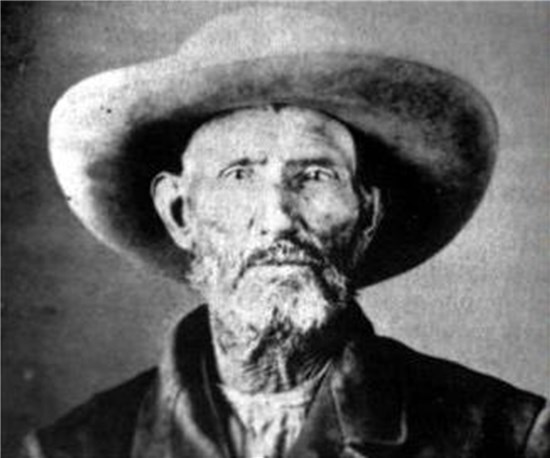

Jim Bridger (1804-1881)
by Michael Hughes
Each year 6 million vacationers follow Jim Bridger’s footsteps into Rocky Mountain and Yellowstone National Parks. Some of their ancestors, westbound merchants and immigrants, relied for over 120 years on the trails and mountain passes promoted by that same mountain man.
Jim Bridger was born on the eastern seaboard of the U.S., the week Lewis and Clark departed on the first epic journey of western discovery. In 1822, a teenaged Bridger followed their path as part of an early fur expedition up the Missouri River from St. Louis. Over the next twenty years, his success and survival among the Rocky Mountains depended on his skills working with other trappers and with Native Americans. His nickname, “Old Gabriel,” suggests he was credited with the leadership insight of an archangel. It helped that Bridger could communicate in seven or more European and Indian languages and that his three successive spouses were Salish, Ute, and Shoshone. Sadly, each wife died following the birth of one of Bridger’s seven children.
The oft-widowed Bridger unwisely bought into a fur company that collapsed when the fad for beaver felt hats declined. He was shrewder about the prospects of overland emigration and commerce to the Pacific. Bridger had earlier been one of the rediscoverers of South Pass, the key to development of the Oregon-California Trail. In 1843, Bridger and Louis Vasquez opened Fort Bridger, the most significant trading post on the western portion of this route. Bridger was often absent, several times leading hunting expeditions for two different British aristocrats. During these “safaris,” Bridger became one of the first non-Indians to explore present Rocky Mountain National Park.
During a return to his trading post, Bridger lost the enterprise when driven off−for reasons unclear—by a Mormon posse. Ironically, he had earlier advised Brigham Young on Mormon migration to Great Salt Lake (which Bridger was the first non-Indian to describe). To finance boarding school care for his children (arranged by friend Father Pierre Jean De Smet), the impoverished Bridger hired out during the 1860s as a guide to miners, engineers, and army commanders. Meanwhile, his stories about the Yellowstone region were encouraging others to launch the first organized exploration of what became America’s first national park.
During his own expeditions, Bridger laid new routes from Denver to the Pacific coast, the Montana gold fields, and Salt Lake City. However, his most important contribution to transportation had been back in 1850 when he revealed the existence of Bridger Pass. This disclosure enabled a burgeoning of traffic across the center of the United States over the Continental Divide. During the 1860s, the Pony Express, the Overland Stage Line, and the first transcontinental railroad all traveled west via Bridger Pass.
By 1868, Bridger was able to retire and reconnect with his children. He settled on a farm at Little Santa Fe, south of Kansas City, Missouri. Five years later, his health and eyesight began to fail. After his death in 1881, Bridger was forgotten until Gen. Grenville Dodge became his champion.
Recommended Reading
Alter, J. Cecil, Jim Bridger. University of Oklahoma Press, 1962.
Hafen, LeRoy R., ed., Mountain Men and Fur Traders of the Far West. University of Nebraska Press, 1982.
Vestal, Stanley, Jim Bridger, Mountain Man. W. Morow & Company, 1946; reprint University of Nebraska, 1970.
Michael Hughes
Dr. Michael Hughes of Oklahoma has represented to date twelve historical figures for state humanities councils, universities, Indian nations, and the Library of Congress. He has appeared most frequently as Michelangelo Buonarotti, Alexander Graham Bell, and Orson Welles. Last year in Greeley he appeared as Cherokee Chief John Ross. Prior to retirement he taught and was an editor of publications in art history, American history, and Native American studies. His wife, Dr. Eril Hughes, is a professor of English. He currently spends much of his time researching, writing, traveling, and visiting grandchildren.
Bullet Points
-
Jim Bridger’s second wife was a Colorado Ute (Nuche).
-
Bridger’s first son went by the name “Rocky Mountain Felix” because he was born in the Colorado Rockies.
-
Bridger laid out the first roads between Denver and a) the Oregon Trail, b) the Montana gold fields, and c) Great Salt Lake (which he was the first non-Indian to see) and Salt Lake City.
-
Bridger was among the first non-Indians to explore Colorado’s North Park and Middle Park.
-
Bridger was among the first men to explore present-day Rocky Mountain National Park, specifically its west side and the Grand Lake area.
Quotes
-
“He had the whole West mapped out in his mind” (General Grenville Dodge).
-
“This gentleman was a famous mountain man, and we venture to say that no one who sic has travelled here [to the West] within the last 30 years without seeing or hearing of him” (Artist Alfred Jacob Miller).
-
“That he was making history never once occurred to him , But I doubt if we'd have been here if it weren't for men like Jim” (Johnny Horton song “Jim Bridger”).
Timeline
1804 Bridger is born in or near Richmond, Virginia.
1812 Bridger’s family moves to the Mississippi River across from St. Louis, Missouri.
1822-42 Bridger is an employee or part-owner of Rocky Mountain fur companies.
1834/1855 Bridger explores present Rocky Mountain National Park while leading hunting expeditions for English nobles.
c.1835-52 Bridger marries, outlives, and has children by women of three Indian nations.
1843-53 Bridger and Louis Vasquez operate a major trading post near the junction of the Oregon and California trails.
1850 Bridger reveals the location of Bridger Pass, soon the most important pass across the Rockies.
1857-68 Bridger leads army expeditions and establishes routes from Denver to the Montana gold fields and Great Salt Lake.
1866 Bridger creates serious interest in present Yellowstone National Park.
1881 Bridger dies at his farm south of Kansas City, Missouri.